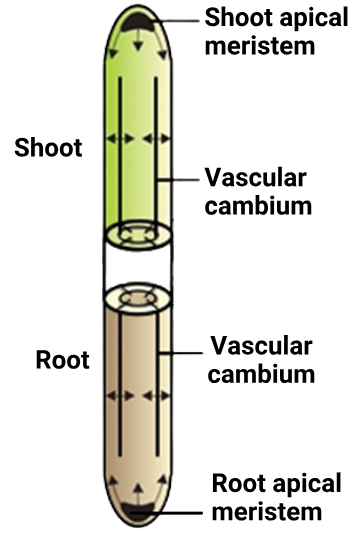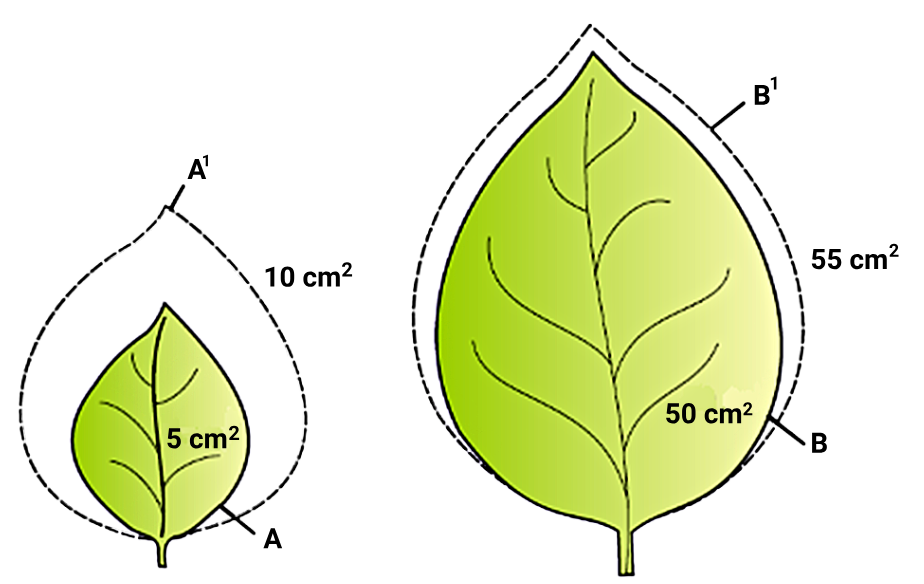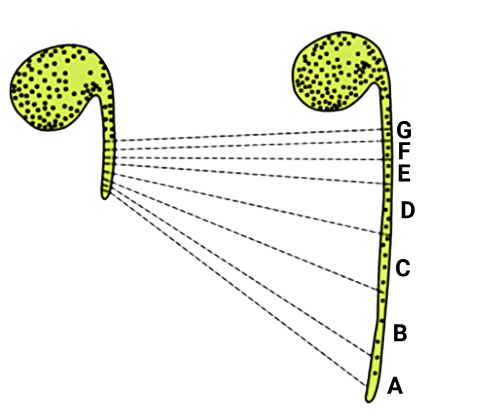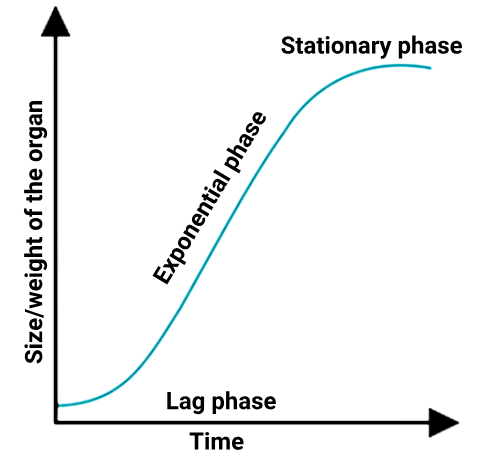Plant Growth and Development NCERT
Quiz Summary
0 of 45 Questions completed
Questions:
Information
You have already completed the quiz before. Hence you can not start it again.
Quiz is loading…
You must sign in or sign up to start the quiz.
You must first complete the following:
Results
Results
0 of 45 Questions answered correctly
Your time:
Time has elapsed
You have reached 0 of 0 point(s), (0)
Earned Point(s): 0 of 0, (0)
0 Essay(s) Pending (Possible Point(s): 0)
Categories
- Not categorized 0%
- 1
- 2
- 3
- 4
- 5
- 6
- 7
- 8
- 9
- 10
- 11
- 12
- 13
- 14
- 15
- 16
- 17
- 18
- 19
- 20
- 21
- 22
- 23
- 24
- 25
- 26
- 27
- 28
- 29
- 30
- 31
- 32
- 33
- 34
- 35
- 36
- 37
- 38
- 39
- 40
- 41
- 42
- 43
- 44
- 45
- Current
- Review
- Answered
- Correct
- Incorrect
-
Question 1 of 45
1. Question
1 point(s)In Section 13.1.1 NCERT says that plant growth is unique. What is the character of plant growth being referred to?
CorrectIncorrectHint
(b)
The correct answer is 2. Capacity of unlimited growth throughout life.Explanation:Plants have the unique ability to continue growing indefinitely throughout their lifespan due to the presence of meristems, specialized regions of actively dividing cells in their bodies. This capacity for unlimited growth is what sets plant growth apart from most animals, which typically have a predetermined growth period and stop growing once they reach maturity.Why other options are incorrect:-
1. Plants have a closed growth:This is incorrect. Plants have open growth, meaning they can continue to grow indefinitely. Closed growth would imply a finite lifespan, which is not the case for plants.
-
3. Complete absence of growth after a certain age:This contradicts the definition of plant growth. While some plants might slow down their growth rate as they age, they never completely stop growing.
-
4. Growth without development:Growth and development are interconnected processes in plants. Growth refers to the increase in size and mass, while development refers to the maturation and differentiation of tissues and organs. Plants exhibit both growth and development. Therefore, “growth without development” is not an accurate description of plant growth
-
Question 2 of 45
2. Question
1 point(s)Match Column I [phase of growth] and Column II [cell characteristics] and choose the correct answer from the codes given:
\(
\begin{array}{|l|l|l|}
\hline & \text { COLUMN I } & \text { COLUMN II } \\
\hline \text { A } & \text { Meristematic } & \begin{array}{l}
\text {a. Increased vacuolation, new cell wall } \\
\text { deposition }
\end{array} \\
\hline \text { B } & \text { Elongation } & \text { b. Thin cellulosic wall with abundant plasmodesmatal connections } \\
\hline \text { C } & \text { Maturation } & \text { c. Maximal wall thickening } \\
\hline
\end{array}
\)Codes:
\(
\begin{array}{|l|l|l|l|}
\hline & \text { A } & \text { B } & \text { C } \\
\hline 1 . & \text { a } & \text { b } & \text { c } \\
\hline 2 . & \text { b } & \text { c } & \text { a } \\
\hline 3 . & \text { b } & \text { a } & \text { c } \\
\hline 4 . & \text { c } & \text { b } & \text { a } \\
\hline
\end{array}
\)CorrectIncorrectHint
(c)
-
Question 3 of 45
3. Question
1 point(s)Identify the incorrect statement regarding the arithmetic growth?
CorrectIncorrectHint
(a)
Explanation: In arithmetic growth, only one daughter cell continues to divide after mitosis, while the other differentiates and matures. This is why the growth is linear, as the increase in size is constant with each cell division
-
Question 4 of 45
4. Question
1 point(s)Plant growth and further development is intimately linked to water status of the plant because:
A. Turgidity of cells helps in extension growth
B. It provides medium for enzymatic activityCorrectIncorrectHint
(a)
-
Question 5 of 45
5. Question
1 point(s)Select the correct statements based on the information shown below in the diagrammatic representation of location of root apical meristem, shoot apical meristem and vascular cambium where the arrows exhibit the direction of growth of cells and organs:

Statement I: The root apical meristem and the shoot apical meristem are responsible for the primary growth of the plants and principally contribute to the elongation of the plants along their axis.
Statement II: In dicots and gymnosperms, the lateral meristems, vascular cambium and cork-cambium appear later in life and cause the increase in the girth of the organs in which they are active.CorrectIncorrectHint
(a)
-
Question 6 of 45
6. Question
1 point(s)NCERT in section 13.1.5 emphasizes an optimum temperature range for living organisms. The optimum temperature range for proper growth in most plants is:
\(
\begin{array}{|l|l|}
\hline 1.0^{\circ} \mathrm{C}-100^{\circ} \mathrm{C} & 2.15^{\circ} \mathrm{C}-20^{\circ} \mathrm{C} \\
\hline 3.28^{\circ} \mathrm{C}-30^{\circ} \mathrm{C} & 4 . \text { Greater than } 45^{\circ} \mathrm{C} \\
\hline
\end{array}
\)CorrectIncorrectHint
(c)
-
Question 7 of 45
7. Question
1 point(s)Consider the given diagram and select the correct inference:
 CorrectIncorrect
CorrectIncorrectHint
(c)
-
Question 8 of 45
8. Question
1 point(s)Based on the given diagram of root tip, which of the following statements will be true?

I: The region shown as A to G is the zone of elongation.
II. The portion of the axis which is undergoing the phase of maturation lies more distal to the phase of elongation.CorrectIncorrectHint
(a)
✅ Statement I: “The region shown as A to G is the zone of elongation.”
-
While in general, the zone of elongation is only part of this A–G span (usually C–E), some textbooks and exam frameworks loosely generalize A–G as the active growth region, focusing on elongation as the dominant process happening after cell division.
-
So, in the context of many school-level biology exams, A to G may be collectively labeled as the elongation zone—even if that’s not fully precise anatomically.
➡️ So this statement is accepted as “correct” in some answer keys due to simplified textbook conventions.
❌ Statement II: “The portion of the axis which is undergoing the phase of maturation lies more distal to the phase of elongation.”
-
This is actually correct scientifically (maturation zone lies distal/farther from tip),
-
But some sources interpret “distal” differently in the context of roots (mistaking proximal/distal due to polarity), or possibly expect “beyond elongation zone” to mean closer to the root tip, which would make the statement wrong in their key.
-
Question 9 of 45
9. Question
1 point(s)The growth in plants can be best expressed as (refer NCERT Section 15.2):
CorrectIncorrectHint
(a)
-
Question 10 of 45
10. Question
1 point(s)Plasticity in plant growth means that
CorrectIncorrect -
Question 11 of 45
11. Question
1 point(s)Assertion: Plants retain the capacity for unlimited growth throughout their life.
Reason: Plants have meristems at certain locations in their body.CorrectIncorrectHint
(a)
-
Question 12 of 45
12. Question
1 point(s)The given curve:-

I: is characteristic of living organism growing in a natural environment.
II: is typical for all cells, tissues and organs of a plant.CorrectIncorrectHint
(c)
-
Question 13 of 45
13. Question
1 point(s)The exponential growth in plants can be expressed as: \( \mathrm{W}_1=\mathrm{W}_0 \mathrm{e}^{\mathrm{rt}} \) where ‘ e ‘ denotes:
CorrectIncorrectHint
(b)
-
Question 14 of 45
14. Question
1 point(s)The diagram given shows heterophylly in Larkspur. What will be true regarding this phenomenon?

I: It is more important for plants than most animals.
II. Plants have open growth and development.CorrectIncorrectHint
(b)
❓ Does II explain I?
This is the key issue.
-
Open growth means continuous growth through meristems.
-
Plasticity is the ability to adapt development in response to environment.
Although open growth provides a mechanism for plasticity, it does not fully explain why plasticity is more important for plants than animals. The key reason plasticity is more important for plants is because they are immobile—they can’t escape environmental stressors.
Open growth (II) is a feature of plants, but does not directly explain why plasticity is more important for plants than animals (I).
-
Question 15 of 45
15. Question
1 point(s)Consider the given two statements:
I: Differentiation in plants is open.
II: Cells/tissues arising out of the same meristem have different structures at maturity.CorrectIncorrectHint
(a)
-
Question 16 of 45
16. Question
1 point(s)Development is a term that includes all changes that a plant goes through during its life cycle:
CorrectIncorrectHint
(d)
-
Question 17 of 45
17. Question
1 point(s)The diagram shows the schematic representation of an experiment that made bioassay of auxins possible. This experiment was done by:
 CorrectIncorrect
CorrectIncorrectHint
(d)
-
Question 18 of 45
18. Question
1 point(s)Difference in shapes of leaves produced in air and those produced in water represents heterophyllous development due to environment in:
CorrectIncorrectHint
(d)
-
Question 19 of 45
19. Question
1 point(s)Identify Incorrectly matched pair:-
\(
\begin{array}{|l|l|l|}
\hline & \text { PGR } & \text { Chemical Nature } \\
\hline \text { 1. } & \text { Auxins } & \text { Indole compounds } \\
\hline \text { 2. } & \text { Cytokinin } & \text { Pyrimidine derivatives } \\
\hline \text { 3. } & \text { ABA } & \text { Carotenoid derivative } \\
\hline \text { 4. } & \text { Gibberellic acid } & \text { Terpenes } \\
\hline
\end{array}
\)CorrectIncorrectHint
(b)
Cytokinin Pyrimidine derivatives❌ Incorrect – Cytokinins are purine derivatives (e.g., kinetin is a modified adenine)
-
Question 20 of 45
20. Question
1 point(s)Identify Incorrectly matched pair:-
\(
\begin{array}{|l|l|l|}
\hline & \text { Scientist } & \text { PGR discovery } \\
\hline \text { 1. } & \text { Cousins } & \text { Ethylene } \\
\hline \text { 2. } & \text { Kurosawa } & \text { Gibberellin } \\
\hline \text { 3. } & \text { Skoog and Miller} & \text { ABA } \\
\hline \text { 4. } & \text { F. W. Went} & \text { Auxin } \\
\hline
\end{array}
\)CorrectIncorrectHint
(c)
Skoog and Miller ABA ❌ Incorrect – Skoog & Miller discovered cytokinin, not ABA. ABA was discovered independently by Addicott and others.
-
Question 21 of 45
21. Question
1 point(s)By continually removing apical buds, horticulturists can remodel a tree or a shrub into remarkable shapes as shown in the given figure. The reason is:
 CorrectIncorrect
CorrectIncorrectHint
(a)
-
Question 22 of 45
22. Question
1 point(s)Match the following:
\(
\begin{array}{|l|l|}
\hline \text { A. IAA } & \text { i. Herring sperm DNA } \\
\hline \text { B. ABA } & \text { ii. Bolting } \\
\hline \text { C. Ethylene } & \text { iii. Stomatal closure } \\
\hline \text { D. GA } & \text { iv. Weed-free lawns } \\
\hline \text { E. Cytokinins } & \text { v. Ripening of fruits } \\
\hline
\end{array}
\)Options:
\(
\begin{array}{|l|l|l|l|l|}
\hline & \text { A } & \text { B } & \text { C } & \text { D } \\
\hline 1 . & \text { iv } & \text { iii } & \text { V } & \text { ii } \\
\hline 2 . & \text { V } & \text { iii } & \text { iv } & \text { ii } \\
\hline 3 . & \text { iv } & \text { i } & \text { v } & \text { iii } \\
\hline 4 . & \text { V } & \text { iii } & \text { ii } & \text { i } \\
\hline
\end{array}
\)CorrectIncorrectHint
(a)
-
Question 23 of 45
23. Question
1 point(s)The term synergistic action of hormones refers to
CorrectIncorrectHint
(c)
-
Question 24 of 45
24. Question
1 point(s)Identify the correct statements regarding auxins?
I: Auxin stimulates cell elongation by stimulating wall-loosening factors, such as expansins, to loosen cell walls.
II: When auxin and cytokinin are applied to callus, rooting can be generated with higher auxin to cytokinin ratios, shoot growth is induced by lower auxin to cytokinin ratios.
III: Auxin induces the formation and organization of phloem and xylem.
IV: In low concentrations, auxin can inhibit ethylene formation and transport of precursor in plants; however, high concentrations can induce the synthesis of ethylene.CorrectIncorrectHint
(d)
All are correct
-
Question 25 of 45
25. Question
1 point(s)The removal or inactivation of which of the following will lead to germination of many types of dormant seeds?
CorrectIncorrectHint
(a)
-
Question 26 of 45
26. Question
1 point(s)Consider the given statements:
I. Auxin was first isolated from human urine.
II. They are generally produced by the growing apices of the stems and the roots.
III. IAA and IBA are synthetic auxins.
IV. NAA and 2,4-D have been isolated from plants.CorrectIncorrectHint
(a)
Statement III: IAA and IBA are synthetic auxins.
❌ Incorrect. Both indole-3-acetic acid (IAA) and indole-3-butyric acid (IBA) are naturally occurring auxins found in plants. IAA is the most abundant natural auxin, while IBA is also synthesized by plants and plays a role in root development.
Statement IV: NAA and 2,4-D have been isolated from plants.
❌ Incorrect. Naphthaleneacetic acid (NAA) and 2,4-dichlorophenoxyacetic acid (2,4-D) are synthetic auxins; they are not naturally occurring in plants but are chemically synthesized and widely used in agriculture to regulate plant growth
-
Question 27 of 45
27. Question
1 point(s)Consider the given two statements:
I: Removal of shoot tips is widely applied in hedge making and tea plantations.
II: Removal of shoot tips usually results in the growth of lateral buds.CorrectIncorrectHint
(a)
-
Question 28 of 45
28. Question
1 point(s)Auxins:
I. promote flowering in pineapples
II. induce parthenocarpy in tomatoes
III. like 2,4-D kill monocot weeds
IV. control xylem differentiationCorrectIncorrectHint
(b)
like 2,4-D kill dicot weeds not monocot weeds
-
Question 29 of 45
29. Question
1 point(s)Consider the given two statements:
I: Spraying sugarcane crop with gibberellins increases the yield by as much as 20 tonnes per acre.
II: Sugarcane stores carbohydrates as sugar in their stems and spraying sugarcane crop with gibberellins increases the length of the stem.CorrectIncorrectHint
(a)
-
Question 30 of 45
30. Question
1 point(s)How many of the following can be characterized as action of gibberellins on plants?
I. They can be used to increase the length of grape stalks.
II. They can elongate and improve the shape of apple.
III. They speed up malting process in brewing industry.
IV. They hasten the maturity period of juvenile conifers.
V. They promote bolting in many plants with rosette habit.CorrectIncorrectHint
(d)
All are correct
-
Question 31 of 45
31. Question
1 point(s)Cytokinins:
I. Help produce new leaves, chloroplasts in leaves, lateral shoot growth and adventitious root formation.
II. Help overcome the apical dominance.
III. Promote nutrient mobilisation, which helps in the delay of leaf senescence.CorrectIncorrectHint
(d)
All are correct
-
Question 32 of 45
32. Question
1 point(s)What will be true for plant growth regulator involved in the responses in plants as shown in the given figure?

\(
\begin{aligned}
&\begin{array}{|l|l|}
\hline \text { I: } & \text { The PGR is ABA. } \\
\hline \text { II: } & \text { Chemically, it is a terpene. } \\
\hline \text { III: } & \begin{array}{l}
\text { Seed germination is inhibited by it in antagonism } \\
\text { with gibberellin. }
\end{array} \\
\hline \text { IV: } & \begin{array}{l}
\text { It is also produced in the roots in response to } \\
\text { decreased soil water potential. }
\end{array} \\
\hline
\end{array}\\
&\begin{array}{|l|l|l|l|}
\hline \text { 1. } & \text { Only I, II and III } & 2 . & \text { Only I, II and IV } \\
\hline \text { 3. } & \text { Only I, III and IV } & 4 . & \text { Only II, III and IV } \\
\hline
\end{array}
\end{aligned}
\)CorrectIncorrectHint
(c)
-
Abscisic Acid (ABA) is not a “true terpene” in the classical sense.
-
It is derived from carotenoids, specifically oxidative cleavage of a 40-carbon carotenoid.
-
Technically, ABA is a sesquiterpenoid, derived from a C15 intermediate.
-
Some sources classify it more accurately as a terpenoid (oxygen-containing derivative of terpenes), not a pure terpene.
-
Question 33 of 45
33. Question
1 point(s)Consider the given two statements:
I: The most widely used compound as source of ethylene is ethephon.
II: Ethephon in an aqueous solution is readily absorbed and transported within the plant and releases ethylene slowly.CorrectIncorrectHint
(a)
-
Question 34 of 45
34. Question
1 point(s)Which of the following is not a use of plant PGR ethylene?
CorrectIncorrectHint
(d)
Auxin, another plant growth regulator, is responsible for inducing parthenocarpy in tomatoes.
-
Question 35 of 45
35. Question
1 point(s)Match the following concerning the activity/function and the phytohormone involved:-
\(
\begin{aligned}
&\text { }\\
&\begin{array}{|l|l|l|l|}
\hline \text { (a) } & \text { Fruit ripener } & \text { (i) } & \text { Abscisic acid } \\
\hline \text { (b) } & \text { Herbicide } & \text { (ii) } & \text { GA 3 } \\
\hline \text { (c) } & \text { Bolting agent } & \text { (iii) } & \text { 2, 4-D } \\
\hline \text { (d) } & \text { Stress hormone } & \text { (iv) } & \text { Ethephon } \\
\hline
\end{array}
\end{aligned}
\)
\(
\begin{aligned}
& \text { Select the correct option from following:- } \\
& \begin{array}{|l|l|l|l|l|}
\hline & \text { (a) } & \text { (b) } & \text { (c) } & \text { (d) } \\
\hline 1 . & \text { (ii) } & \text { (iii) } & \text { (iv) } & \text { (i) } \\
\hline 2 . & \text { (iii) } & \text { (iv) } & \text { (ii) } & \text { (i) } \\
\hline 3 . & \text { (iv) } & \text { (iii) } & \text { (ii) } & \text { (i) } \\
\hline 4 . & \text { (iv) } & \text { (ii) } & \text { (i) } & \text { (iii) } \\
\hline
\end{array}
\end{aligned}
\)CorrectIncorrectHint
(c)
-
Question 36 of 45
36. Question
1 point(s)The ripening of fruits can be accelerated by
CorrectIncorrectHint
(d)
-
Question 37 of 45
37. Question
1 point(s)In plants, oxygen is utilised in
CorrectIncorrectHint
(b)
-
Question 38 of 45
38. Question
1 point(s)Which of the following is not true w.r.t. growth in organisms ?
CorrectIncorrectHint
(d)
-
Question 39 of 45
39. Question
1 point(s)Apical dominance means:-
CorrectIncorrectHint
(b)
-
Question 40 of 45
40. Question
1 point(s)Which phytohormone would we use if we are asked to delay the ripening of fruits so as to extend the period for marketing?
CorrectIncorrectHint
(a)
-
Question 41 of 45
41. Question
1 point(s)All of the following are functional applications of ethylene, except
CorrectIncorrectHint
(d)
GA is used to speed up the malting process in
brewing industry -
Question 42 of 45
42. Question
1 point(s)Cytokinins:-
CorrectIncorrectHint
(d)
-
Question 43 of 45
43. Question
1 point(s)In plants, relative growth can be represented as
CorrectIncorrectHint
(c)
-
Question 44 of 45
44. Question
1 point(s)Select the odd one out w.r.t. the cells of maturation zone.
CorrectIncorrectHint
(c)
-
Question 45 of 45
45. Question
1 point(s)Development is the sum of two processes that are
CorrectIncorrectHint
(a)